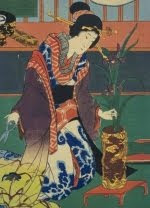When Sofu Teshigahara founded the Sogetsu School in 1926, it all started up in a small scale. After causing some turbulence in Japan in the 1930s for its non traditional style, nothing much happened until after World War II. Ikebana was a popular activity among the wives of US army soldiers stationed in Japan after the war, and they helped spread the practice of ikebana around the world.
The interest in Sogetsu ikebana seems to have exploded in those years. Sofu's book "Ikebana: Japanese Flower Arrangements", published in the early 1950s reports that the followers of his school exceeds 400000.
Although it looks a bit simple to the modern eye, this must have been an impressive book in it's time. I may be wrong, but to me it looks like some of the color photos are actually hand-coloured black and white photos. Hand-colouring of photographs was a popular techinique in Japan from the 1860s, and stayed popular long after it was concidered old fashioned in the West. You'll find many of the classic Sofu ikebana arrangements with comments in the book: Quite a few of Sofu's large scale sculptural ikebana with dried wood and stone, and a series of miniatyr ikebana "Pygmé flowers" in small vases and lipstick conatiner tops. There are also really nice interior pictures from the studio of Sofu and work in progress pictures showing Sofu in action. A whole series of photos shows a team of helpers constructing the large scale work "The Locomotive". It even has the sketches by Sofu's hands.

The wide range of ikebana arrangements and the photos from Sofu's studio is what makes this a true reference book. There is also a rich biographic presentation of Sofu's life and background written by art historian and art critic Sumio Mizusawa, telling the seldom told story about the father of Sofu who founded "Japan Floral Institute" and chocked the ikebana establishment by introducing a teaching technique with dial plates and fixed numbers of degrees for the positions of the flowers. Although Sofu emphasized the free expression and introduced the modern free style and avantgarde ikebana, he stuck to his fathers teaching methods for the basic styles. These methods are still in use by all the major ikebana schools.
It's difficult to find this book today. I've seen it listed with publication year varying from 1947 to 1954. It sometimes has a modernistic drawing and sometimes a photo of an ikebana arrangement on the dust jacket. In my opinion it's worth buying even in a less than perfect condition.
Ikebana: Japanese Flower Arrangements
by Sofu Teshigahara
With "Sofu Teshigahara - His Life And Art" by Sumio Mizusawa
Photo by Ken Domon
Studio Publications Inc, New York, undated, ca 1950-1952
With "Sofu Teshigahara - His Life And Art" by Sumio Mizusawa
Photo by Ken Domon
Studio Publications Inc, New York, undated, ca 1950-1952
Hardcover, 84 pages, colour and black and white photos.












No comments:
Post a Comment